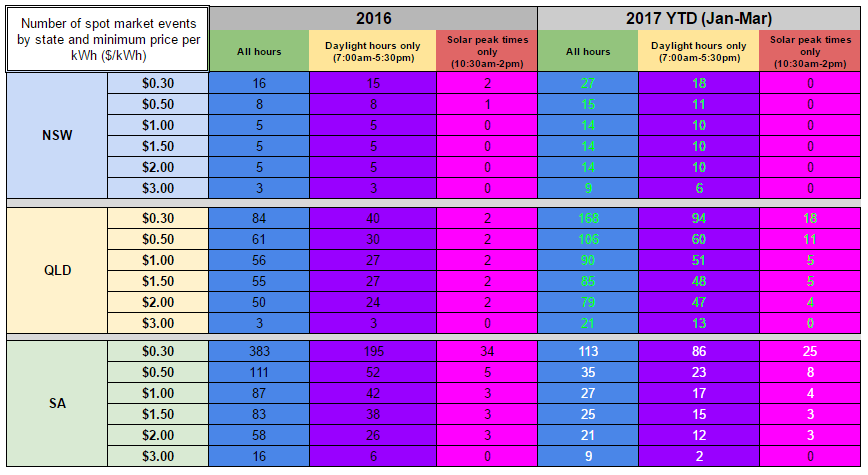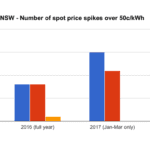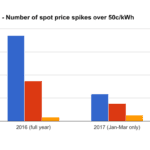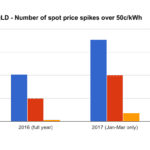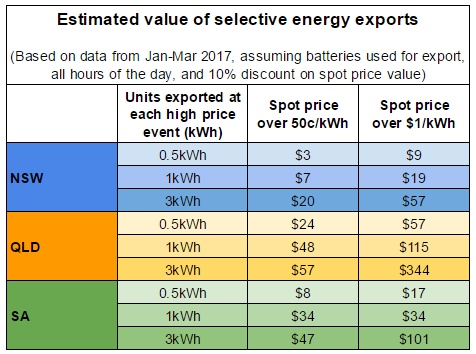Now that solar feed-in tariff rates are so low across the country, there’s little reason for a solar system owner to send their energy back into the grid, as they will almost always save more money by ‘self-consuming‘ their solar energy. This is one of the reasons that the popularity of battery storage systems has grown so rapidly; they promise an unprecedented degree of energy self-sufficiency for households around Australia.
Interestingly, however, the rise of battery storage has breathed new life into the concept of ‘premium’ feed-in tariffs. Depending on their setup and arrangement with their electricity retailer, solar and battery storage system owners may be rewarded for occasionally sending their energy into the grid when there is need for it. Reposit Power’s GridCredits program (compatible with a handful of retail electricity plans) is arguably the most well-recognised example of this, but several network-based trials that are similar in concept are also underway in various locations. Now defunct electricity retailer Urth Energy also offered something similar with its Urth Trader package, which offered a solar feed-in tariff based on the wholesale electricity spot price on the National Electricity Market (NEM).
Compare solar & battery storage quotes in your area
Compare Solar & Battery Quotes
What is selective energy export?
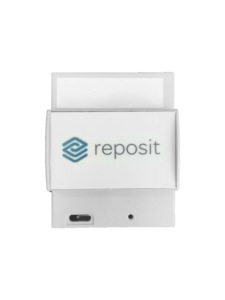 As noted above, Reposit Power’s GridCredits program has gained the most commercial traction and is the most readily recognised its kind in Australia – but it’s not the only one. It’s useful to use a more generalised term to refer to such programs – we think the terms ‘selective feed-in’ or ‘selective energy export’ capture the concept nicely.
As noted above, Reposit Power’s GridCredits program has gained the most commercial traction and is the most readily recognised its kind in Australia – but it’s not the only one. It’s useful to use a more generalised term to refer to such programs – we think the terms ‘selective feed-in’ or ‘selective energy export’ capture the concept nicely.
Selective energy export stands in contrast to traditional solar export / solar feed-in tariffs, under which there is a blanket value given to all solar energy sent into the grid, regardless of its utility at the time of export. Instead, selective export programs incentivise solar & battery system owners to send their energy into the grid only at certain times – paying a higher rate when the spot market price is high, for example. In fact, the spot market price is (for the time being) likely to be the primary reference point for selective export programs.
The exact form that selective feed-in can take will vary depending on the program offered. Some programs (like Diamond Energy’s GridCredits100 plan, enabled by Reposit’s technology gateway) pay a flat rate of $1.00 for each kilowatt-hour (kWh) of stored electricity exported to the grid when the spot price goes above a certain threshold (even if that price is in excess $1/kWh). Others may offer a rate that is in line with the wholesale spot market, or some combination of the two.
Is selective export worth it?
The biggest question mark that popped up over our heads when we first heard about GridCredits was about the frequency of these sorts of events – taking advantage of spot market spikes doesn’t mean much if there are only 2 or 3 per year. You could ask the same questions about (now defunct retailer Urth Energy’s) Urth Trader plan – a spot market-based feed-in tariff sounds great when you only look at the peaks, but how often do they actually occur?
A promotional video for (now defunct) electricity retailer Urth Energy’s Urth Trader plan. Urth Trader offered a solar feed-in tariff based on the NEM spot price.
What do historic spot market prices indicate?
We understood that both these programs are based loosely on the wholesale spot market price, but ordinary people haven’t an inkling about what the spot price does on a daily, seasonal or annual basis. While the developers of selective export technologies or programs won’t generally go out of their way to show you the numbers (and the past is no predictor of the future), the data is actually freely available on the AEMO website for anyone with the means and determination to parse through it.
The number of spikes has increased
When you do look at the numbers, the results may surprise you (they certainly surprised us!). The tables below show the number of times that the spot market price went above a range of thresholds in the whole of 2016 vs just the first three months of 2017 for three key states – NSW, QLD and SA.
As you can see, the number of spikes is already significantly higher than last year in QLD and NSW – and SA looks as though it could be on track to at least match last year’s numbers as well. One of the likely reasons behind this trend is the extreme heat that Australia faced this past summer – which lead to leaps in electricity demand as huge numbers of people switched on their energy-hungry air conditioning units. The demand drove spot market prices sky high.
An overview of the number of spot market price spikes about a spread of prices in three key states (whole of 2016 vs Jan-Mar 2017). The number of spikes has increased markedly since last year.
The tables below show the number of price spikes above 50c/kwh in the same three states. We estimate that the spot market price would need to be at least 50c/kWh for a solar/storage system owner to justify exporting energy under a selective feed-in program.
Most of the spikes happen outside of ‘peak sunshine’ periods
It’s also worthwhile noting that the smallest number of peaks occurred during ‘peak solar’ times – i.e. the middle of the day when solar output is usually at its highest. This has implications for system owners aiming to do selective export based on solar output only (as opposed to battery output). Namely, there are likely to be fewer opportunities for solar-only system owners to benefit, as opposed to those who also have batteries.
Does the higher number of spikes mean bigger savings for selective energy exporters?
Now the crucial question: How much will a selective export program actually earn you? The answer is impossible to pin down, given the range variables between that come into play, but we’ve made some educated guesses below. We want to emphasise that the resultant figures are very rough, but hope that they are nonetheless useful and instructive.
For simplicity’s sake, we’ve assumed that a system owner will earn 40c/kWh every time the spot market price goes over 50c/kWh, or 90c/kWh every time it goes over $1.00/kWh (i.e. the retailer keeps 10%). We then looked at three export volume scenarios: Whether the home/business exports 0.5kWh, 1kWh or 3kWh at each price spike.
The results are enlightening: Over the first three months of 2017, the amount of credit that someone could earn from selective export could range between as little as $3 to as much as nearly $350 – depending on the state, rate paid and amount of energy sent back to the grid. (At the moment, Queensland appears to be the best place for selective export programs.)
Depending on how much you pay for electricity in the first place – or how much you’re currently saving with solar and/or batteries – these credits could be a small but welcome drop in the bucket, or could have a massive impact on your energy bill.
Remember: Past trends don’t predict the future
Spot market price spikes have certainly increased between this year and last (not to mention previous years), but whether or not this will remain a permanent feature of the wholesale market is unknowable. What we can be fairly sure of, however, is that distributed generators (e.g. home energy system owners) are only going to become more important in the country’s energy infrastructure going forward. With this fundamental shift, the number of ways in which system owners can leverage their market interactivity is highly likely to grow.
The verdict about selective export: Sure, why not?
The key takeaway for anyone reading this article is this: If you have the opportunity to ‘do’ selective export with solar and/or batteries, it’s likely to be worth it provided that the enabling technology:
- Is cost-effective (doesn’t significantly inflate the cost of your system); and
- Also provides other services, such as energy monitoring, insight notifications and remote control of aspects of the energy system within your home.
Also keep in mind the fact that opportunities to benefit from selective export are likely to increase as the grid becomes more distributed and interactive. With this trend, the number of home energy systems equipped with ‘gateway’ technologies (such as home energy management systems) that enable selective export is also likely to grow.
And don’t forget that the main way that solar & battery system owners will save money is to use their energy themselves. In our opinion, selective export will always be a bonus on top of the savings possible through self-consumption.
Watch this space!
Get free, instant solar & battery storage quote comparisons
Compare Solar & Battery Quotes
Other resources
Try our Simple Solar PV Payback Estimator Tool
Learn more about battery storage: Check out our Battery Storage 101 page
Try our Solar & Battery Storage Sizing & Payback Estimator Tool
Check out our Battery Storage Product Performance Comparison Tool
See the rest of our calculators in our Calculator Resource Library
© 2017 Solar Choice Pty Ltd
- Solar Power Wagga Wagga, NSW – Compare outputs, returns and installers - 13 March, 2025
- Monocrystalline vs Polycrystalline Solar Panels: Busting Myths - 11 November, 2024
- Solar Hot Water System: Everything You Need to Know - 27 February, 2024
